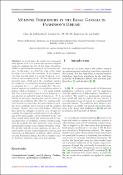Options
Multiple Frequencies in the Basal Ganglia in Parkinsons Disease
Date Issued
2015-09
Date Available
2019-03-27T12:49:02Z
Abstract
In recent years, the authors have developed what appears to be a very successful phenomenological model for analyzing the role of deep brain stimulation (DBS) in alleviating the symptoms of Parkinson's disease. In this paper, we extend the scope of the model by using it to predict the generation of new frequencies from networks tuned to a specific frequency, or indeed not self-oscillatory at all. We have discussed two principal cases: firstly where the constituent systems are coupled in an excitatory-excitatory fashion, which we designate by ``+/+''; and secondly where the constituent systems are coupled in an excitatory-inhibitory fashion, which we designate ``+/-''. The model predicts that from a basic system tuned to tremor frequency we can generate an unlimited range of frequencies. We illustrate in particular, starting from systems which are initially non-oscillatory, that when the coupling coefficient exceeds a certain value, the system begins to oscillate at an amplitude which increases with the coupling strength. Another very interesting feature, which has been shown by colleagues of ours to arise through the coupling of complicated networks based on the physiology of the basal ganglia, can be illustrated by the root locus method which shows that increasing and decreasing frequencies of oscillation, existing simultaneously, have the property that their geometric mean remains substantially constant as the coupling strength is varied. We feel that with the present approach, we have provided another tool for understanding the existence and interaction of pathological oscillations which underlie, not only Parkinson's disease, but other conditions such as Tourette's syndrome, depression and epilepsy.
Sponsorship
Science Foundation Ireland
Type of Material
Journal Article
Publisher
Advances in Electric and Electronic Engineering
Journal
Biomedical Engineering
Volume
13
Issue
3
Start Page
249
End Page
254
Copyright (Published Version)
2015 Advances in Electrical and Electronic Engineering
Language
English
Status of Item
Peer reviewed
This item is made available under a Creative Commons License
File(s)
Loading...
Name
insight_publication.pdf
Size
470.31 KB
Format
Adobe PDF
Checksum (MD5)
10a621dc2fe39c52790c4ccbb9f803d0
Owning collection